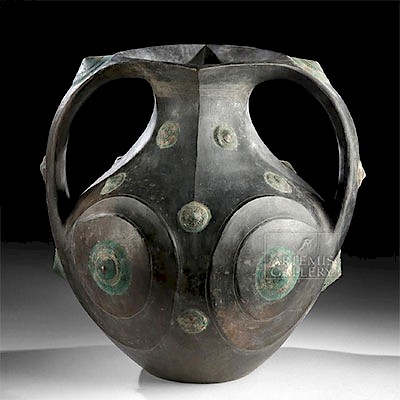Three 18th & 19th C. British Pewter Steins & Tankard
Lot 178
About Seller
Artemis Gallery
686 S Taylor Ave, Ste 106
Louisville, CO 80027
United States
Selling antiquities, ancient and ethnographic art online since 1993, Artemis Gallery specializes in Classical Antiquities (Egyptian, Greek, Roman, Near Eastern), Asian, Pre-Columbian, African / Tribal / Oceanographic art. Our extensive inventory includes pottery, stone, metal, wood, glass and textil...Read more
Estimate:
$900 - $1,400
Absentee vs Live bid
Two ways to bid:
- Leave a max absentee bid and the platform will bid on your behalf up to your maximum bid during the live auction.
- Bid live during the auction and your bids will be submitted real-time to the auctioneer.
Bid Increments
| Price | Bid Increment |
|---|---|
| $0 | $25 |
| $300 | $50 |
| $1,000 | $100 |
| $2,000 | $250 |
| $5,000 | $500 |
| $10,000 | $1,000 |
| $20,000 | $2,500 |
| $50,000 | $5,000 |
| $100,000 | $10,000 |
| $200,000 | $20,000 |
About Auction
By Artemis Gallery
Jul 11, 2019
Set Reminder
2019-07-11 10:00:00
2019-07-11 10:00:00
America/New_York
Bidsquare
Bidsquare : Ancient / Ethnographic / Americana
https://www.bidsquare.com/auctions/artemis-gallery/ancient-ethnographic-americana-4246
Discover ancient art from Egypt, Greece, Italy, and the Near East, as well as Asian, Pre-Columbian, Tribal, Fossils and Fine Art. Also featuring a wonderful collection from a prominent New York estate whose owners reside in the Van Wyck family's historic Lloyd Harbor waterfront home. Artemis Gallery info@artemisgallery.com
Discover ancient art from Egypt, Greece, Italy, and the Near East, as well as Asian, Pre-Columbian, Tribal, Fossils and Fine Art. Also featuring a wonderful collection from a prominent New York estate whose owners reside in the Van Wyck family's historic Lloyd Harbor waterfront home. Artemis Gallery info@artemisgallery.com
- Lot Description
Europe, Great Britain/United Kingdom, ca. 1780 to 1891 CE. A duo of antique pewter steins and one pewter tankard. One, made in 1780, bears the initials "J. D. K." on the lid with the date, and has a shield-like motif on a floral field, with the words "Es Bluhe" and "Jacksen" - perhaps family names - inscribed under the rim. The lid has a large lid atop its handle with a spherical finial. The second lacks a date, but its inscribed writing suggests a similar time frame as the first. Unfortunately this writing is now worn and nearly impossible to read. A stamp that reads "QUART" is under the rolled rim. A thick handle is on one side; there is no lid. Size of largest (tankard): 7.25" W x 5.75" H (18.4 cm x 14.6 cm)
The third is a commemorative tankard, larger than the other two, and roughly a century newer - dated 1891 - with three large handles and no lid. On the underside it is stamped, "K", a trumpet symbol, "James Dixon and Sons, Sheffield", "497", "Rowell", and "4". On one side, it reads, "Hertford College Scratch Fours 1891" and then the names of the four student rowers and the coxswain alongside their positions in the boat. The Hertford College crest, a hart's head with a cross above it, is at the center. Hertford College is one of Oxford's more than 30 constituent colleges, with former students including John Donne, Jonathan Swift, Thomas Hobbes, and Evelyn Waugh, the latter of whom, when asked what sport he played for his college, famously replied that he drank for it. This vessel commemorates the "scratch boat" from one of the rowing regattas that pepper the University of Oxford's schedule - the Victorian equivalent of a "beer boat".
Provenance: private Long Island, New York, USA collection
All items legal to buy/sell under U.S. Statute covering cultural patrimony Code 2600, CHAPTER 14, and are guaranteed to be as described or your money back.
A Certificate of Authenticity will accompany all winning bids.
We ship worldwide and handle all shipping in-house for your convenience.
#147381The lid of the one from 1780 is very slightly bent but completely functional.Condition
- Shipping Info
-
All shipping is handled in-house for your convenience. Your invoice from Artemis Gallery will include shipping calculation instructions. If in doubt, please inquire BEFORE bidding for estimated shipping costs for individual items.
-
- Buyer's Premium



 EUR
EUR CAD
CAD AUD
AUD GBP
GBP MXN
MXN HKD
HKD CNY
CNY MYR
MYR SEK
SEK SGD
SGD CHF
CHF THB
THB



















